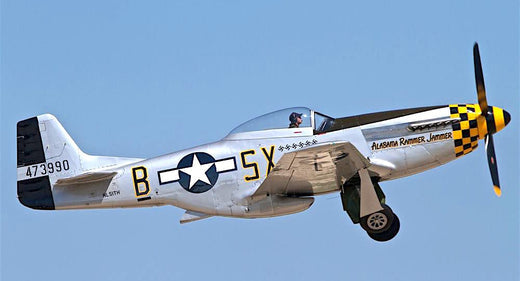This Fine Art Print by Artist Craig Tinder commemorates the pilots of the Eighth Air Force's 353rd Fighter Group and includes an actual P-51D Mustang relic.
Details About the RELIC:
 P-51D Mustang 44-73990 Skin relics from the 15-year restoration
P-51D Mustang 44-73990 Skin relics from the 15-year restoration
This particular fragment of a P-51D-25-NA Mustang came from the fuselage panel of aircraft 44-73990 (Construction No. 122-40530). Built in 1944, it initially served with the US Army Air Force before being transferred to the Royal Canadian Air Force in 1951.
After changing hands several times, the aircraft eventually joined the air racing circuit under the name "Pigeon Chaser." It was flown by the legendary R.A. "Bob" Hoover as the pace plane for the 1971 Cape May National Air Races.
 P-51D Mustang 44-73990 Air Racer "Pigeon Chaser"
P-51D Mustang 44-73990 Air Racer "Pigeon Chaser"
From 2000 to 2015, the aircraft underwent extensive restoration and is now painted in the livery of "Alabama Rammer Jammer," representing the 353rd Fighter Group, the same unit featured in the artwork.
 P-51D Mustang 44-73990 "Alabama Rammer Jammer"
P-51D Mustang 44-73990 "Alabama Rammer Jammer"
The Story Behind the Print:
This art piece captures a pair of P-51D Mustangs from the renowned 352nd Fighter Squadron, 353rd Fighter Group, of the Mighty Eighth Air Force, as they patrol over occupied Europe. Stationed at RAF Raydon in England during World War II, the 353rd Fighter Group played a crucial role in escorting bombers on nearly 450 combat missions and participated in key historical events such as the Battle of Normandy, Operation Market Garden, and the Battle of the Bulge.
The two aircraft depicted in this scene highlight the legacy of the brave pilots who flew these missions, each with a unique story to tell. One of the featured aircraft is Alabama Rammer Jammer, piloted by Arthur C. Cundy Jr., an ace with 7.5 confirmed aerial victories. Cundy hailed from Birmingham, Alabama, and came from a family steeped in military service, with his father a veteran of World War I and his mother, Virginia Key, a recruiting officer and descendant of Francis Scott Key, writer of "The Star-Spangled Banner." On March 11, 1945, while piloting his P-51D Mustang #44-15092, "Alabama Rammer Jammer," Cundy tragically disappeared over the North Sea due to a coolant leak, and his remains were never recovered.
The second aircraft is Double Trouble Two, flown by Lieutenant Colonel William “Wild Bill” Bailey, Deputy Group Commander of the 353rd Fighter Group, known for the distinctive black-and-yellow checkers on its nose and propeller spinner. A seasoned pilot, Bailey flew 186 combat missions over two operational tours, with 32 of those missions in the P-51. His aircraft bore six aerial victory symbols, honoring his success in aerial combat, with three enemy planes destroyed in the air and three more on the ground. Bailey’s Mustang, Double Trouble Two, gained its name after his first aircraft, "Double Trouble," was destroyed in a crash—so named after Bailey left two girlfriends behind in the United States.
This detailed art print offers a tribute to the skill, bravery, and sacrifice of the pilots who flew in the 353rd Fighter Group. With the powerful legacy of Alabama Rammer Jammer and Double Trouble Two, it serves as a testament to the heroism of the 352nd Fighter Squadron and the pivotal role they played in securing victory during WWII.
 Photos from 353rd FG Ace Lt. Louis Lee - Commissioned by Artist
Photos from 353rd FG Ace Lt. Louis Lee - Commissioned by Artist
About the P-51D Mustang
When the Mustang first graced the skies in 1940, it carried with it an Allison V-1710 engine. And while this engine was commendable at lower altitudes, its performance began to taper off sharply as it climbed. Given the high-altitude aerial duels that often characterized WWII dogfights, this was a significant shortfall.
The Meeting of Titans
It wasn't until a fateful collaboration between British and American engineers that the Mustang's destiny shifted. They hypothesized: What would happen if the P-51, with its already stellar aerodynamics, married the raw high-altitude prowess of the Rolls-Royce Merlin engine?
Thus, the Packard V-1650 Merlin was born – an American-made version of the Rolls-Royce powerhouse. It was like the stars aligned just for aviation.
Unleashing the Beast
Incorporating the Merlin into the Mustang was more than just a simple engine swap. This was the blending of British engineering finesse with American industrial might. The resulting P-51B and subsequent models showcased an astonishing increase in performance. The Mustang could now accompany bombers to the heart of Nazi Germany and back, proving instrumental in the Allies' daylight bombing campaign.
With the Merlin's supercharger singing its tune, the P-51 could maintain peak performance at much higher altitudes, often having the edge over its German counterparts. The Luftwaffe pilots, once kings of the European skies, found themselves contending with a rejuvenated adversary that wasn't just their equal but often their superior.
Legacy of the Merlin Magic
The transformative impact of the Merlin engine on the P-51 Mustang is an enduring testament to how critical components can define the fate of entire systems. It's a reminder that sometimes, the sum of parts can lead to a holistic evolution, elevating something good to legendary status.
In the dance of engineering and warfare, the P-51 and Merlin engines waltzed together in a harmony that changed the course of history. In their legacy, we find an ode to innovation, resilience, and the sheer magic that can emerge when vision meets necessity.
Learn more about the The Crown Jewel of World War II Aviation of the P-51 Mustang. Click Here
To purchase or see similar items, visit here.
Commissioned by Museums, Treasured by Collectors





Share:
Ace Over England, the story behind "Invaders Across the Channel"
Heroes and Foes, the story behind "Commander's Oversight"